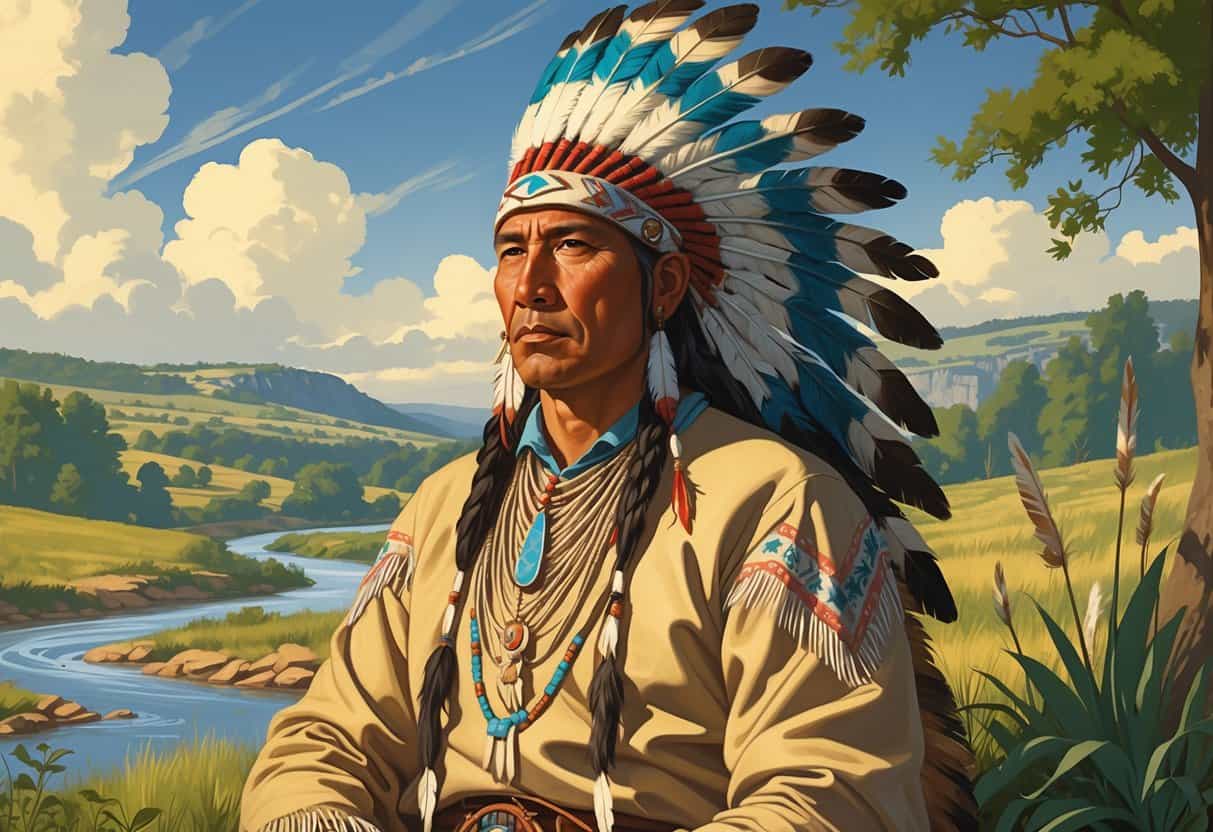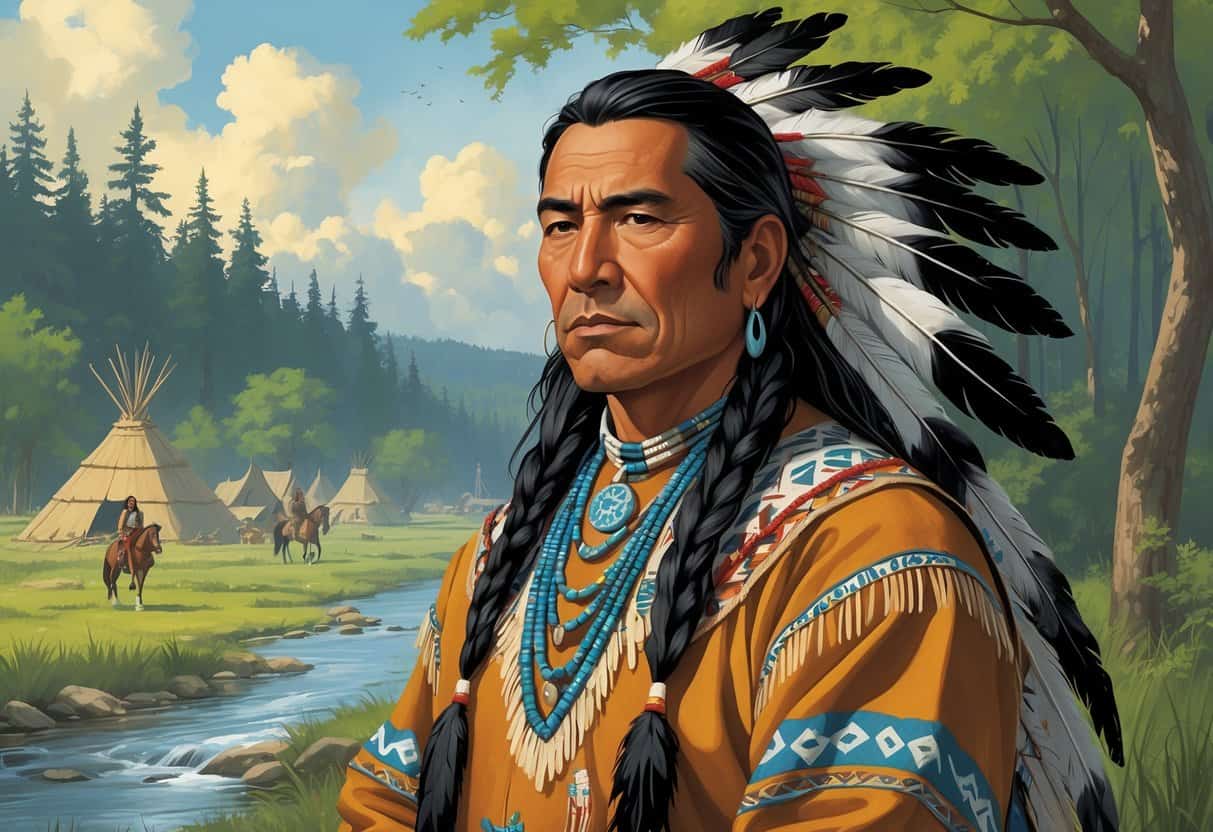Black Hawk was a leader and warrior of the Sauk tribe. He fought hard to protect his people’s land from American expansion.
He’s best known for leading resistance against forced removal and for his role in the Black Hawk War of 1832. He wasn’t officially a chief, but folks respected him deeply as a medicine man and war leader.

You’ll get a look at Black Hawk’s background and the tough choices he faced. His story is important, not just for his tribe, but for understanding Native American history during that era.
This guide covers the key events that shaped his life. You’ll find the bigger themes about what Native Americans went through as the U.S. pushed west.
Key Takeways
- Black Hawk led his tribe in resistance to losing their land.
- His life shows key struggles of Native Americans in the 1800s.
- The study guide offers clear summaries and important themes to understand.
Who Was Black Hawk: Background and Context

You need to know the events and places tied to Black Hawk to really get his story. His actions were shaped by big fights and the setting he called home.
Historical Events Leading to October 3
Black Hawk was a leader in a time of conflict and change. In the early 1800s, he fought to protect his tribe’s land from U.S. government forces.
His choice to resist made him a central figure in what became the Black Hawk War. That war defined his legacy.
October 3 is actually known today for a totally different event—“Black Hawk Down”—a battle in Mogadishu, Somalia, in 1993. That’s a modern military operation, not related to the Native American leader. The shared name can be confusing, but it’s just a coincidence.
The Setting: Mogadishu
Mogadishu is the capital of Somalia, over in East Africa. It hit the headlines in 1993 because of the “Black Hawk Down” battle.
That event was a U.S. military mission, not connected to Black Hawk the Sauk leader. Still, the name pops up in both stories, which can throw people off.
Mogadishu’s history is about modern conflict. Black Hawk’s story is about 19th-century struggles over tribal land. Both involve defense and fighting, but they’re worlds apart in time and place.
Key Characters and Analysis
You’ll come across leaders, warriors, and rangers who played big roles in these stories. Understanding their actions helps explain why events played out the way they did.
Notable Figures: Rangers and Their Roles
Rangers were a key group—military scouts and soldiers. They acted as the eyes and ears for the army.
Their main job? Gather info on enemy movements and report back. Some rangers were sharp shooters and skilled trackers, able to handle rough terrain and unpredictable situations.
That made them valuable during conflicts involving Black Hawk and his people. They were often right on the front lines.
Their actions could tip the scale in a fight. The presence of rangers added real tension and urgency to battles.
Character Analysis and Motivations
Black Hawk was a war leader and medicine man, fiercely dedicated to protecting his land and tribe. His motives? Pretty clear—he wanted to resist U.S. expansion and defend his people’s rights.
Other characters had their own goals. Some wanted peace, some just wanted to survive, and others tried to adapt to new realities.
These different motives shaped what happened. Choices made in tense moments often came from conflicting interests.
Looking at their decisions gives you a window into how complicated things were back then. It’s no wonder some conflicts blew up while others fizzled out.
Major Themes and Insights
Here’s where we dig into the big ideas and memorable quotes from these stories. You’ll see themes of conflict, loyalty, and survival—plus some lines that really stick with you.
Themes Explored in Black Hawk Down
One major theme is the chaos and brutality of war. Soldiers faced tough choices and danger they couldn’t always control.
There’s a lot of courage and tragedy woven together in these battles. Loyalty stands out too—loyalty to friends, to the mission, to the country.
Soldiers had to depend on each other. That trust shaped what they did in the heat of the moment.
Survival is huge here. Both soldiers and civilians dealt with fear, loss, and the drive to keep going. The story reveals just how hard it was, physically and mentally.
Quotes That Define the Story
Some quotes stick with you. One soldier says, “We were all just trying to make it out alive.” That raw struggle for survival comes through.
Another line: “In that moment, you only trust the man next to you.” That’s loyalty, right there.
And when someone says, “This war isn’t about winning or losing; it’s about holding onto who we are,” you can feel the deeper stakes. These lines help you get what’s really at the heart of the story.
Chapter Summaries and Study Guide Resources
Here’s a rundown of key events and themes from Black Hawk’s life. You’ll also get some insights from Mark Bowden’s work on related history.
Comprehensive Chapter Summaries
You’ll find chapter summaries that walk you through Black Hawk’s life, starting with his birth in 1767 in Sac Village.
The summaries cover his rise as a Sauk leader and the impact of the 1804 treaty that cost his people their land east of the Mississippi.
Each chapter highlights turning points, like Black Hawk’s choices during conflicts with white settlers and his efforts to protect his tribe’s rights.
These summaries help you follow the story and see the cultural and political challenges the Sauk faced in the early 1800s.
Critical Insights from Mark Bowden
Mark Bowden brings a fresh, modern lens to the events surrounding Black Hawk and the conflicts tied to his story. He digs into military strategy and the wild, unpredictable nature of these battles.
Bowden really zooms in on the gritty details of key encounters. He looks at how tensions between Indigenous tribes and U.S. forces boiled over into violence.
These clashes weren’t just about fighting—they were tangled up in bigger questions of land and power. Bowden’s work helps you see how these moments fit into that wider struggle.
His research gives you more than just facts. You get a sense of the tough choices and chaos that leaders faced back then.